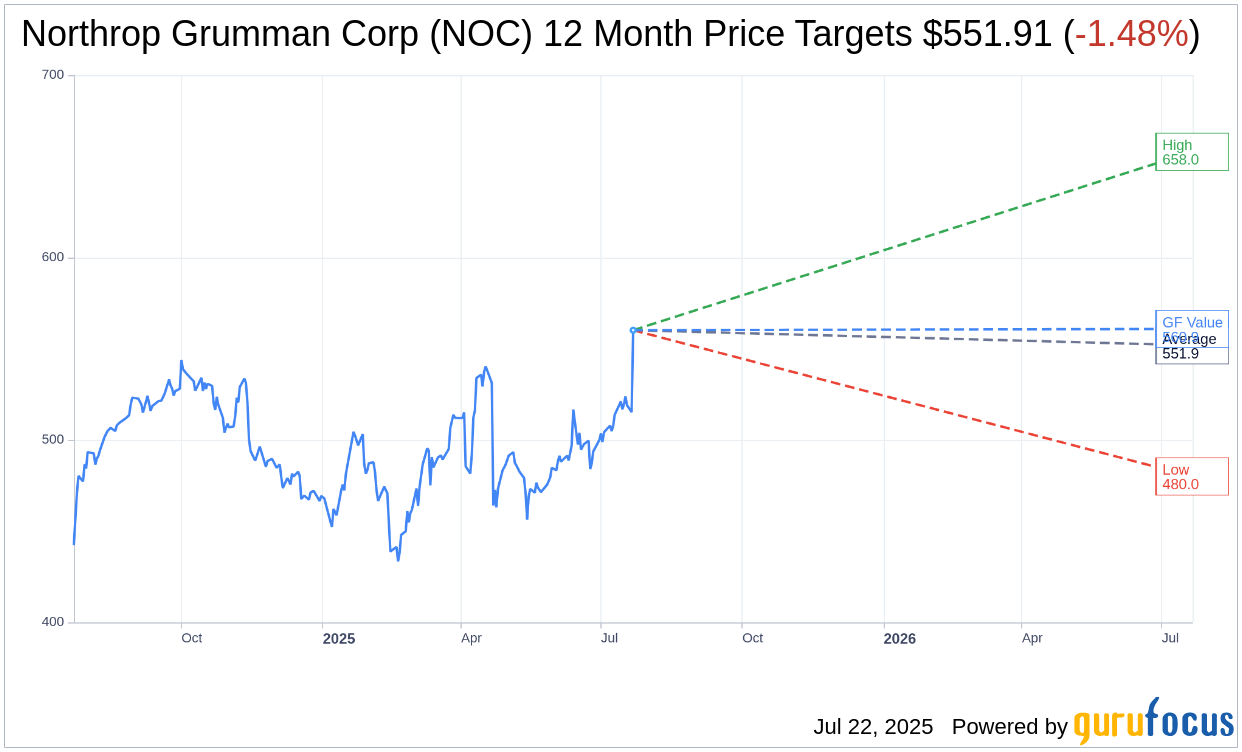Northrop Grumman (NOC, Financial) recently highlighted the significant growth of its Mission Systems segment during the second quarter. The company anticipates that the robust segment margins observed in the first half of the year will continue through the second half of 2025. Additionally, Northrop Grumman announced an agreement with the U.S. Air Force for the new Sentinel ICBM program baseline. These updates were shared during the company’s second-quarter earnings call.
Wall Street Analysts Forecast

Based on the one-year price targets offered by 19 analysts, the average target price for Northrop Grumman Corp (NOC, Financial) is $551.91 with a high estimate of $658.00 and a low estimate of $480.00. The average target implies an downside of 1.48% from the current price of $560.19. More detailed estimate data can be found on the Northrop Grumman Corp (NOC) Forecast page.
Based on the consensus recommendation from 24 brokerage firms, Northrop Grumman Corp's (NOC, Financial) average brokerage recommendation is currently 2.3, indicating "Outperform" status. The rating scale ranges from 1 to 5, where 1 signifies Strong Buy, and 5 denotes Sell.
Based on GuruFocus estimates, the estimated GF Value for Northrop Grumman Corp (NOC, Financial) in one year is $560.89, suggesting a upside of 0.12% from the current price of $560.19. GF Value is GuruFocus' estimate of the fair value that the stock should be traded at. It is calculated based on the historical multiples the stock has traded at previously, as well as past business growth and the future estimates of the business' performance. More detailed data can be found on the Northrop Grumman Corp (NOC) Summary page.
NOC Key Business Developments
Release Date: April 22, 2025
- Revenue: $9.5 billion, down 7% compared to the prior year.
- Backlog: Record backlog of $92.8 billion.
- B-21 Program Loss: $477 million pretax loss due to higher manufacturing costs.
- International Sales: 14% of total sales, with international sales up 11% in the quarter.
- Segment Operating Margin: 6% due to B-21 adjustment.
- Defense Systems Margin Rate: Improved to 9.9%.
- Space Segment Operating Margin: 11% with net favorable EACs of $29 million.
- EPS Impact: B-21 adjustment lowered EPS by $2.74 per share after-tax.
- Operating Cash Flow: Outflow of $1.5 billion.
- Capital Expenditures: Nearly $300 million invested.
- Shareholder Returns: Nearly $800 million returned through dividends and share repurchases.
- 2025 Sales Guidance: $42 billion to $42.5 billion, representing 3% to 4% organic growth.
- Free Cash Flow Guidance: Reaffirmed at $2.85 billion to $3.25 billion.
For the complete transcript of the earnings call, please refer to the full earnings call transcript.
Positive Points
- Northrop Grumman Corp (NOC, Financial) reported a record backlog of $92.8 billion in the first quarter, driven by strong international bookings.
- The company reaffirmed its 2025 financial guidance for sales and free cash flow, indicating confidence in achieving its outlook.
- Significant progress was made on key programs, including the successful static fire test of the Sentinel missile's Stage 1 solid rocket motor.
- Northrop Grumman Corp (NOC) received a nearly $500 million contract for IBCS from the US Army, expanding software development and AI capabilities.
- International sales represented approximately 14% of total sales, with a first-quarter international book-to-bill ratio of 1.45 times, indicating strong growth potential.
Negative Points
- The company recognized a $477 million pretax loss related to the B-21 program due to higher manufacturing and material costs.
- First-quarter sales were down 7% compared to the prior year, impacted by contracting delays and timing of material receipts.
- The B-21 program's financial impact was disappointing, with a total loss provision of $477 million affecting the company's segment operating margin rate.
- There is uncertainty in the US defense budget environment, with delays in new awards affecting sales ramp-up.
- The macroeconomic environment and inflationary pressures have led to increased projected material costs, impacting profitability.
